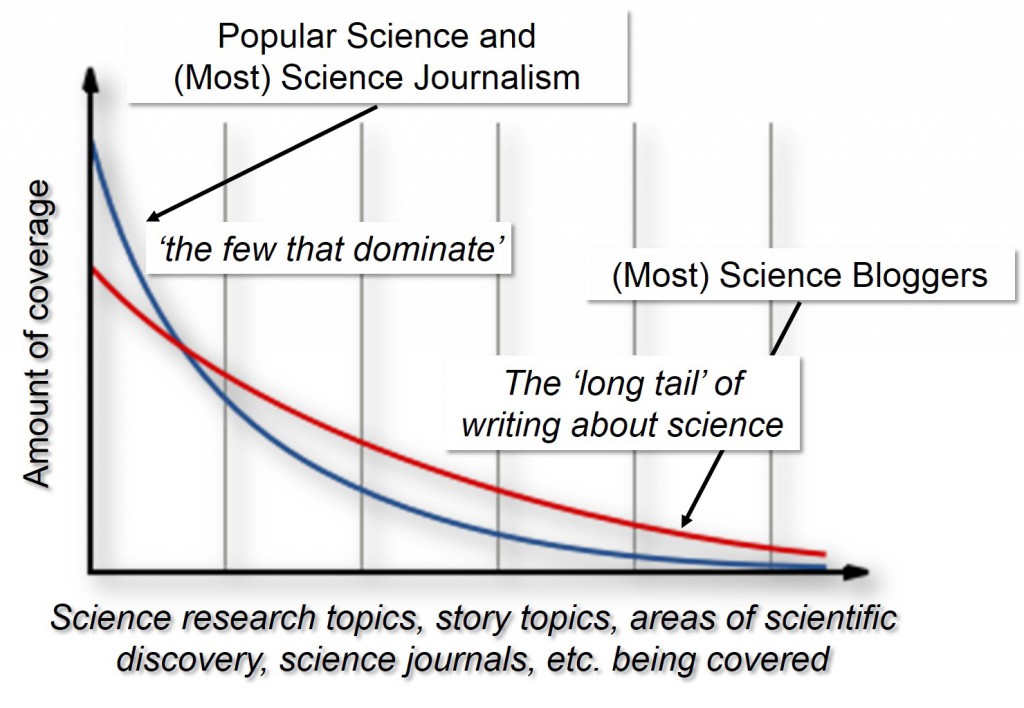Science Bloggers and the Long Tail of Science Writing
"[Science bloggers] challenge the dominant journalistic form forced by the challenges of science news reporting and newsroom culture." - Walejko and Ksaizek 2010
The last few days, I've been using the #MySciBlog hashtag on Twitter to get science bloggers' perspectives on their motivations to blog about science and how they decide what to write about. Yesterday, I posted a Storify that explored the question: Do science bloggers blog about what's popular, or about what's NOT popular in science? In other words, is most science blogging, like most science journalism, focused on the rather narrow selection of scientific topics and/or discoveries that are currently in the news, or that are generally popular among lay audiences? Or do most science bloggers expressly choose to blog about science that is NOT popular, or those scientific research articles and stories that the news media and other bloggers don't seem to be telling? And, perhaps more likely, most science bloggers do a bit of both...
But some of the answers from science bloggers to this question got me thinking - what if science blogs were playing an important role in telling the "long tail" of science stories that traditionally don't make it into popular science outlets and science news? The stories that don't revolve around wine and cancer, MRSA, weird mammal behavior, cybersecurity and robots? (NOT that these aren't hugely important and awesomely cool science topics.)
If I don't write about those species/papers/studies, no one will! #MySciBlog
— Tommy Leung (@The_Episiarch) June 6, 2014
If you aren't familiar with the "long tail" concept, it is used to describe a theory that "our culture and economy is increasingly shifting away from a focus on a relatively small number of 'hits' (mainstream products and markets) at the head of the demand curve and toward a huge number of niches in the tail." (Chris Anderson, The Long Tail). The theory has received support as well as criticism, and has been used to describe the vast number of obscure Netflix titles that get watched despite the dominance of a relatively few 'Blockbusters' everyone sees.
But perhaps the long tail concept applies to science blogging vs. traditional science journalism, especially at a time when science journalism is declining in traditional outlets. Today, when news outlets invest their time in a science story, it most likely is a story involving a paper from a prominent scientific journal (Science, Nature or PNAS, for example), or a scientific topic that has currency and at least the potential for wide popularity.
In a study of the hyperlinking practices of science bloggers, Walejko and Ksiazek concluded that science bloggers provide more "alternative paths of exploration" than political bloggers or other journalistic bloggers. In other words, they link less to traditional news stories and elite sources, and more to other science bloggers, academic sources, original research articles, etc. But even beyond alternative source hyperlinks, science bloggers may be breaking the newsroom conventions that tend to create a focus on a narrow range of scientific topics, journals, sources, findings, etc. There might be a "long tail" of "alternative" science stories, where many (especially aspiring) science bloggers choose 'obscure,' 'unloved' or otherwise under-reported scientific topics and research studies to write about.
At one point in time, or so I've gathered from my research on news practices, if you looked around and saw yourself completely alone in writing a news story on a particular new scientific finding or science topic, you got worried. (Unless you are The New York Times breaking the story, in which case you KNOW others are going to cover it soon anyway.) News coverage has traditionally been about covering what the other outlets were covering, ideally faster and/or with better content. Gatekeeping traditions kept science content in the "big head" region of the graph shown above, with most stories under the left-most section of the blue curve: 'the few that dominate'.
But IF science bloggers - increasingly the majority of science storytellers in online environments - are going after the obscure, unloved and under-reported stories about science, we might start seeing more of the red curve in coverage of science online. An increase in the "long tail" of scientific progress and unanswered questions ignored by the "big popular" content providers. But with enough science bloggers telling those "unloved" science stories, readers today might have access to a wider diversity of information about science than ever before outside of scientific journals, textbooks and lab notebooks.
Because science is freakin' awesome and exciting, and shouldn't just be for those who can afford to read journals #MySciBlog
— Jon Tennant (@Protohedgehog) June 5, 2014
I'm not sure yet if the "long tail" of science coverage actually describes the work of science bloggers, but I'd be happy if it did. I'll let you know what I find as I interview science bloggers this year!
In the meantime, please use the #MySciBlog hashtag to talk about how YOU decide what to write about, and whether you choose to extend "popular" and "current" narratives about science, or whether you choose the topics less traveled.

